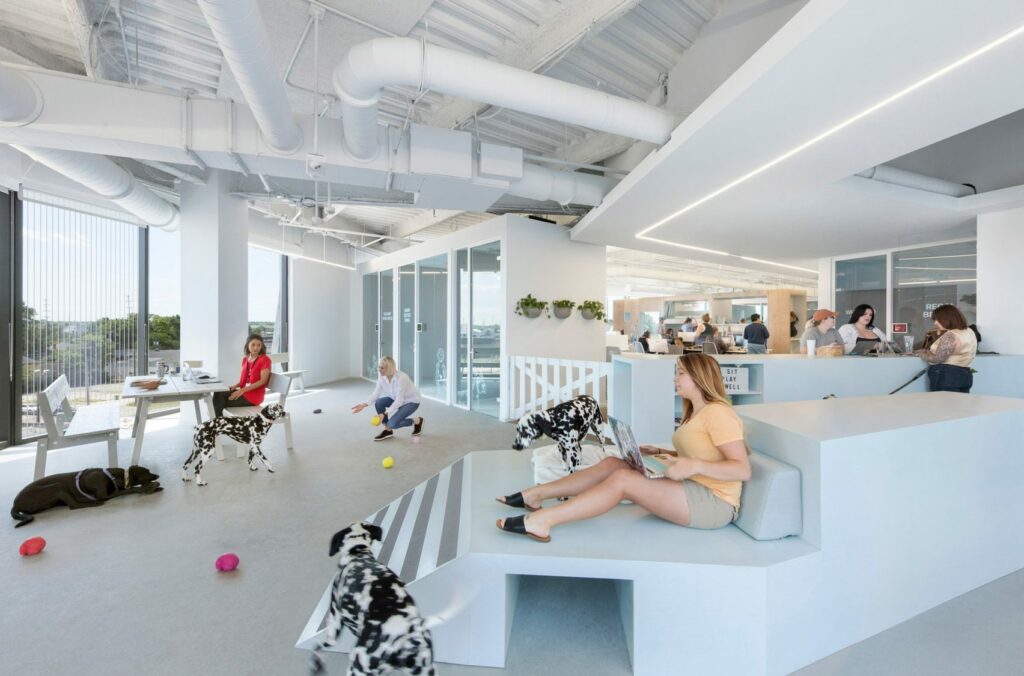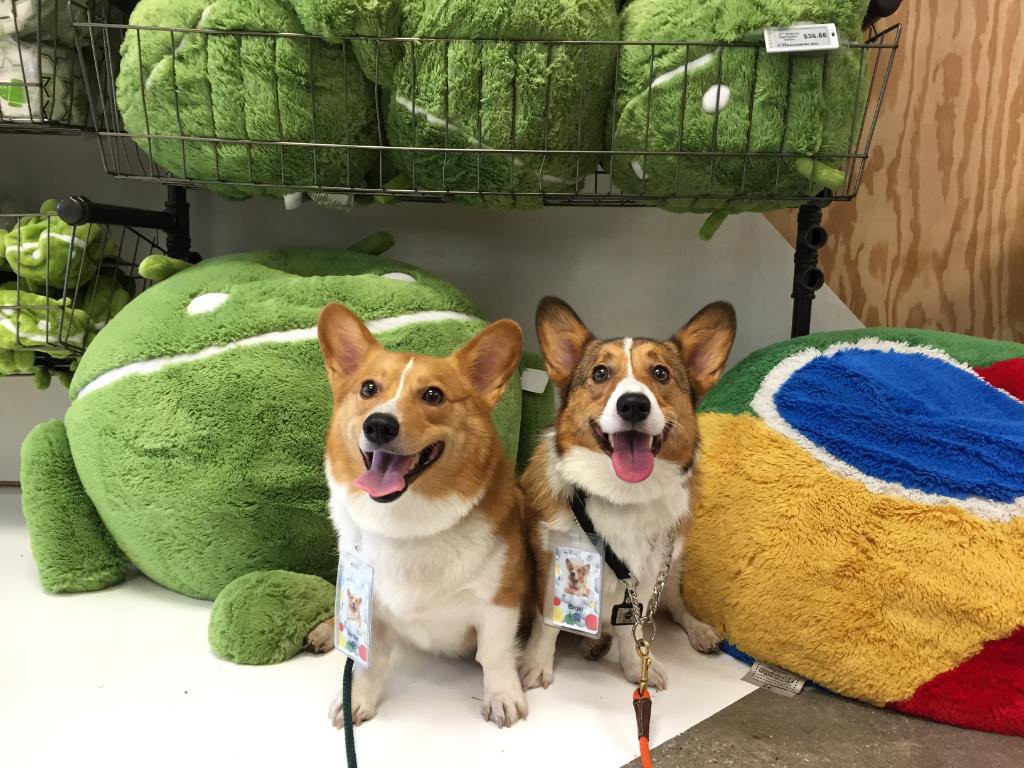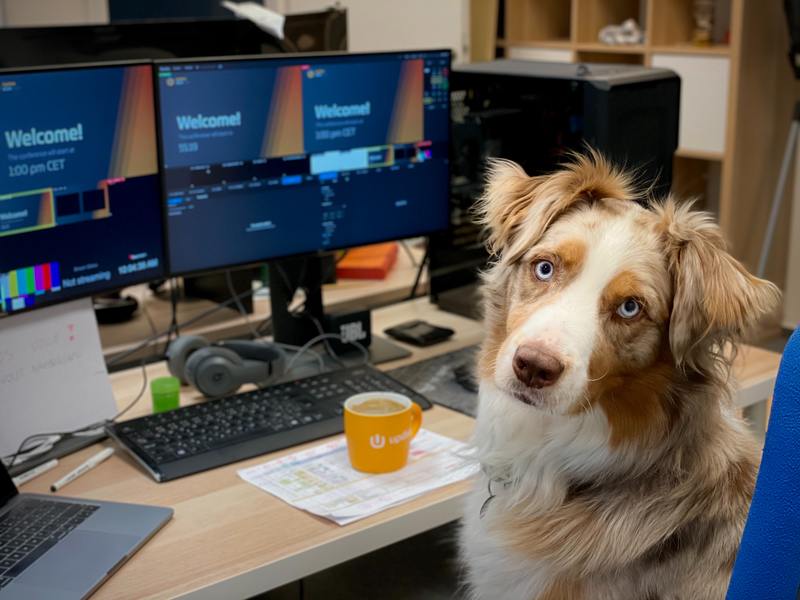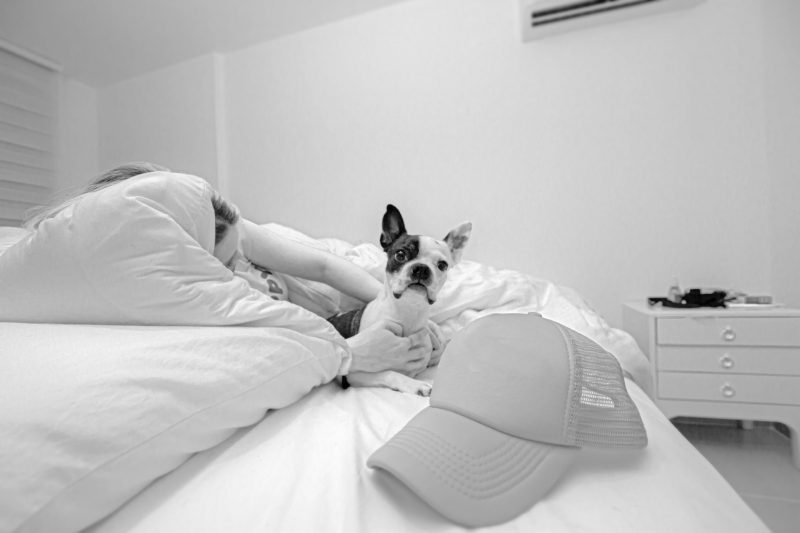If you or your employees have ever frothed over the possibility of bringing dogs to the workplace, you’re far from alone. Companies are introducing pet-friendliness to the employee packet in droves, from Amazon’s ‘Woof Pack’ to the #dogsofcottonon.
While we don’t need to get mathematical about why dogs rock to have around, science has spoken – dogs come with an array of benefits to their owner’s mental and physical wellbeing, benefits that transfer well into the office.
We’re not living in an ideal world. Work is a leading source of stress worldwide, and employment pressure isn’t limited to CEOs and Wall Street brokers. With one in five Aussies taking time off the job because of work-related stress and anxiety, it’s clear the Australian workforce could benefit from some creature comforts.
Not to mention, Aussies are now staring down a brand new beast: logging off Zoom, slipping on some smart-casual pants and returning to the workplace. For those of us who’ve shared a coworking space with our pets over the last 18 months, waving goodbye at the door feels like canine sacrilege.
Introducing dogs to the workplace is a simple step with far-reaching benefits. Interacting with – or just having one mosey about the office space – has been proven to:
- Reduce stress levels, enhance coping skills and lower blood pressure.
- Squash dog-owner guilt about leaving a pet to their lonesome for the day.
- Wipe-out brain fog with lunchtime walks, toilet breaks and forced time in the sun.
- Jack up office morale and communication… “Have you seen Peppin’s bandana today?”
- Spread the benefits of chilling with a dog to the less fortunate (i.e. non-dog owners).
- Build an environment of camaraderie between the manager and their employees. Most workers are massively appreciative of small yet powerful actions like allowing dogs.
Pet-friendly offices in action
Maybe you’re an employer who’s keen to take the leap, but not sure what a canine-inclusive workplace actually looks like.
While tonnes of big name brands have adopted pets into the employee code of conduct, there are a couple leading the charge.

The Bark Office in Ohio, USA is one of the thought leaders in dog-friendly work spaces.
It starts with clever architecture– sleek rubber flooring and faux-leather seating for the (oftentimes dirty) demands of dogs, gated areas for privacy and a “work-and-play lounge”.
The office is outfitted with private rooms for less social dogs (and owners). Water bowls and dog beds are dotted throughout. The Bark Office has a rotation of 20 to 30 dogs – an achievement of its own, if you know dogs – and during design, everything was “consider[ed] from a dog’s perspective first.”
Pet-friendliness doesn’t have to mean a curated workspace. With some minor tweaks to the work environment and some sensible guidelines, even companies totally unrelated to pets can build a dog-friendly office of the future.
Prepare yourself, because this is to die for: Airbnb office dogs get their own personal badges to be scanned in on arrival. Plus, in a bid for equal treatment for man and dog alike, dogs are included on the company database with an employee profile of their own.

Closer to home, parked right across from the sprawling Botanic Gardens and the Tan – a.k.a walkies central – Melbourne Theatre Company has been paving the way for dog-friendly workplaces since its early formation.
The benefits of canine companionship have been officially recognised by the crew at MTC. Dubbing office dog Willow as ‘the mental health first aid officer of the production department,’ a few minutes of puppy love and the demand of being Melbourne’s leading culture creators is wiped clean.
They’ve done it. Amazon, Google and Uber have done it too. With a little elbow grease, so can you.
How to make your office pet friendly
Education, clear guidelines and fair ground rules will be your best friend here.
Dogs are brilliantly, magically, fantastically unique. They vary in breed, personality, preferences, moods and more. They come in varying levels of friendliness towards other dogs, people, and cats that sneak into their backyard.
It’s essential to knuckle down a set of principles that makes everyone feel safe – from boisterous pup to prickly senior. A free-for-all rarely works for dogs in the best of times; in the office, it’s an impending disaster.
Make sure every dog in your office has a place of peace and privacy for when they need it, free from disturbances (and other dogs).
A comfy bed propped under the owner’s desk is a perfect, cost effective option, if remodeling your office for dogs isn’t quite in the budget. Spreading desks out is another simple way of introducing space, or you may risk a day of dog-footsie.
A crucial consideration is whether your office will have a space where dogs can mingle and (occasionally) play. Though it sounds blissful, this does come with its own set of complications, so consider it carefully.
A roster could be really useful here. If only two dogs are allowed in the free roam space at one time, and only pre-established pairs, your chance of chaos is hugely reduced.
Next, think about the people. What capabilities do you and your employees have to moderate their dogs during the day? Do you have a close-knit company of 9 (like us!), or work in a corporation of hundreds?
For employees who aren’t so keen on dogs (can’t relate), it’s worth carving out a canine-free space for them to work comfortably. Do you have a multi-floor office? You could just open one up to dogs.
Or, consider allowing dogs in the office just one or two days a week then offer everyone the chance to work from home that day if they’d prefer to skip the pup parade.
For free roaming spaces with intermingling dogs, it’s essential that someone’s supervising at all times. Consider setting these up around breaktimes.
Set up some guidelines
- Figure out what kind of schedule your office has for dogs, how many can attend at a time, and on what days.
- Are dogs to be leashed, crated, penned or gated? Can they roam, play and socialise with other dogs in the office?
- Establish some rules around dog etiquette and behaviour.
- Make sure your employees are up to scratch on canine body language and human etiquette. Personal space isn’t just for people!
Dogs in this office must be:
- Vaccinated 🦠
- A potty training graduate
- A good boy at heart (and in action)
- Plays nice with others
- Pretty chill (won’t disturb the peace)
- No plus-ones 🦟
Consider your infrastructure
- If dogs are allowed to free-roam, do you have gated or inaccessible areas to control movement?
- Are your floors made from easy cleaning material, or are cleaning products accessible?
- Do you have a grassy patch outside for toilet breaks? Providing eco-friendly poop bags here would be a big bonus, for your employees and the environment. 🌱

Know how to handle the tricky bits
Dogs are perfectly imperfect. They can also be unpredictable.
Honest mistakes happen, but knowing how to wrangle them is key to any well-oiled machine. It’s essential to iron out the expectations of each employee and their pet, plus have some guidelines in place for when it doesn’t work out.
If Muffy doesn’t like Woody, maybe it’s best to roster them on different days. If Booker’s not keen on crowds, maybe a solitary office works best for him and his human. If Buddy keeps lifting his leg on the couch cushions, maybe he stays leashed under his owner’s desk. And so on.
Much as we’d like it to be, the workplace isn’t a dog park– too many dogs in a confined space can easily become a canine mosh pit. Here’s where a rotated schedule might benefit you.
Office, meet dog
While some dogs will acclimate to an office easily-breezy, it’s always best to ease them into new and unfamiliar settings.
Before a shift (or on a rostered day off), have your employees bring their dog in for a sniff & explore. Introduce stranger dogs on neutral ground, and make sure to keep the experience low-key. Start with a few hours hours at a time before progressing.
In the early days, employees could consider buddying up: watching each other’s dog when somebody needs to use the bathroom, attend a meeting, and so on.
When dogs in the workplace just isn’t an option
We’ll begrudgingly accept that in some circumstances, a dog-friendly office isn’t in the cards.
It’s our firm belief that flexibility is at the core of any good workplace. Letting employees continue working from home part or full time can be the perfect compromise (plus a super way to reduce office overheads 🔌).
For employees, doggy daycares are popping up like daisies throughout Australia. If leaving your dog home alone just isn’t a viable option, a reputable daycare (or a dog friend) may be exactly what you need.

Making your office pet-friendly is a power move.
It’s good for you, your employees, and their pets. Do it right, and you can stir up office morale and productivity in a big way.
Don’t let the idea of pets in the office spook you. With a little planning and an office full of educated pet lovers, man’s best friend could easily become your next coworker.






